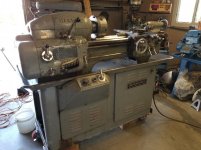First post here!
I am potentially going to get my hands on a Hendey Tool & Gage lathe. I am told that it does not run when powered up.
AHL 40037 is the serial number.
The lathe MIGHT have all the original bits inside (but I am not sure, of course). I would like to try to get it running using the original system, unless it goes against the conventional wisdom or is prohibitively expensive. It seems that there are a number of drive systems for these machines, and I am in no way an electrical expert, so this may be a big project.
Thanks for any help!!!
(I PM'd Hendeyman with a similar note, but my "sent" folder shows no messages sent, so I am not sure if it actually went through--in any case it is more fun to have this kind of discussion with everyone anyway)
Cheers!
I am potentially going to get my hands on a Hendey Tool & Gage lathe. I am told that it does not run when powered up.
AHL 40037 is the serial number.
The lathe MIGHT have all the original bits inside (but I am not sure, of course). I would like to try to get it running using the original system, unless it goes against the conventional wisdom or is prohibitively expensive. It seems that there are a number of drive systems for these machines, and I am in no way an electrical expert, so this may be a big project.
Thanks for any help!!!
(I PM'd Hendeyman with a similar note, but my "sent" folder shows no messages sent, so I am not sure if it actually went through--in any case it is more fun to have this kind of discussion with everyone anyway)
Cheers!












